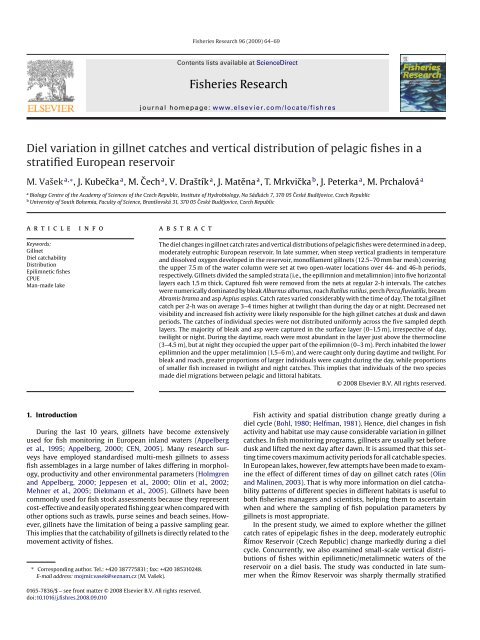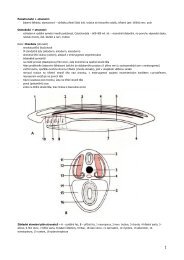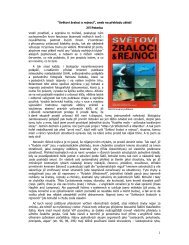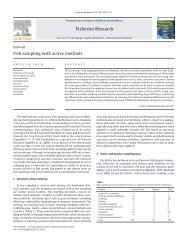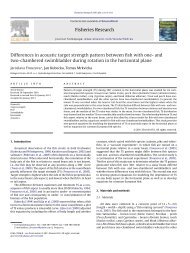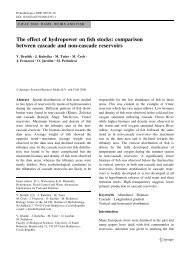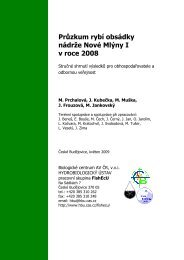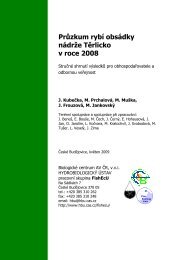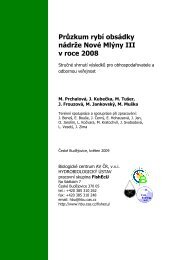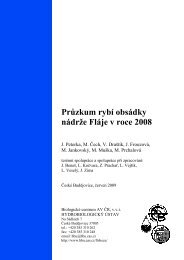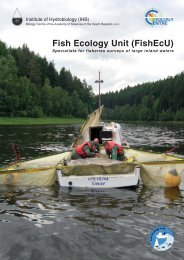Fisheries Research Diel variation in gillnet catches and vertical ...
Fisheries Research Diel variation in gillnet catches and vertical ...
Fisheries Research Diel variation in gillnet catches and vertical ...
Create successful ePaper yourself
Turn your PDF publications into a flip-book with our unique Google optimized e-Paper software.
<strong>Fisheries</strong> <strong>Research</strong> 96 (2009) 64–69<br />
Contents lists available at ScienceDirect<br />
<strong>Fisheries</strong> <strong>Research</strong><br />
journal homepage: www.elsevier.com/locate/fishres<br />
<strong>Diel</strong> <strong>variation</strong> <strong>in</strong> <strong>gillnet</strong> <strong>catches</strong> <strong>and</strong> <strong>vertical</strong> distribution of pelagic fishes <strong>in</strong> a<br />
stratified European reservoir<br />
M. Vašek a,∗ ,J.Kubečka a ,M.Čech a ,V.Draštík a ,J.Matěna a ,T.Mrkvička b ,J.Peterka a , M. Prchalová a<br />
a Biology Centre of the Academy of Sciences of the Czech Republic, Institute of Hydrobiology, Na Sádkách 7, 370 05 České Budějovice, Czech Republic<br />
b University of South Bohemia, Faculty of Science, Branišovská 31, 370 05 České Budějovice, Czech Republic<br />
article<br />
Keywords:<br />
Gillnet<br />
<strong>Diel</strong> catchability<br />
Distribution<br />
Epilimnetic fishes<br />
CPUE<br />
Man-made lake<br />
<strong>in</strong>fo<br />
abstract<br />
The diel changes <strong>in</strong> <strong>gillnet</strong> catch rates <strong>and</strong> <strong>vertical</strong> distributions of pelagic fishes were determ<strong>in</strong>ed <strong>in</strong> a deep,<br />
moderately eutrophic European reservoir. In late summer, when steep <strong>vertical</strong> gradients <strong>in</strong> temperature<br />
<strong>and</strong> dissolved oxygen developed <strong>in</strong> the reservoir, monofilament <strong>gillnet</strong>s (12.5–70 mm bar mesh) cover<strong>in</strong>g<br />
the upper 7.5 m of the water column were set at two open-water locations over 44- <strong>and</strong> 46-h periods,<br />
respectively. Gillnets divided the sampled strata (i.e., the epilimnion <strong>and</strong> metalimnion) <strong>in</strong>to five horizontal<br />
layers each 1.5 m thick. Captured fish were removed from the nets at regular 2-h <strong>in</strong>tervals. The <strong>catches</strong><br />
were numerically dom<strong>in</strong>ated by bleak Alburnus alburnus, roach Rutilus rutilus, perch Perca fluviatilis, bream<br />
Abramis brama <strong>and</strong> asp Aspius aspius. Catch rates varied considerably with the time of day. The total <strong>gillnet</strong><br />
catch per 2-h was on average 3–4 times higher at twilight than dur<strong>in</strong>g the day or at night. Decreased net<br />
visibility <strong>and</strong> <strong>in</strong>creased fish activity were likely responsible for the high <strong>gillnet</strong> <strong>catches</strong> at dusk <strong>and</strong> dawn<br />
periods. The <strong>catches</strong> of <strong>in</strong>dividual species were not distributed uniformly across the five sampled depth<br />
layers. The majority of bleak <strong>and</strong> asp were captured <strong>in</strong> the surface layer (0–1.5 m), irrespective of day,<br />
twilight or night. Dur<strong>in</strong>g the daytime, roach were most abundant <strong>in</strong> the layer just above the thermocl<strong>in</strong>e<br />
(3–4.5 m), but at night they occupied the upper part of the epilimnion (0–3 m). Perch <strong>in</strong>habited the lower<br />
epilimnion <strong>and</strong> the upper metalimnion (1.5–6 m), <strong>and</strong> were caught only dur<strong>in</strong>g daytime <strong>and</strong> twilight. For<br />
bleak <strong>and</strong> roach, greater proportions of larger <strong>in</strong>dividuals were caught dur<strong>in</strong>g the day, while proportions<br />
of smaller fish <strong>in</strong>creased <strong>in</strong> twilight <strong>and</strong> night <strong>catches</strong>. This implies that <strong>in</strong>dividuals of the two species<br />
made diel migrations between pelagic <strong>and</strong> littoral habitats.<br />
© 2008 Elsevier B.V. All rights reserved.<br />
1. Introduction<br />
Dur<strong>in</strong>g the last 10 years, <strong>gillnet</strong>s have become extensively<br />
used for fish monitor<strong>in</strong>g <strong>in</strong> European <strong>in</strong>l<strong>and</strong> waters (Appelberg<br />
et al., 1995; Appelberg, 2000; CEN, 2005). Many research surveys<br />
have employed st<strong>and</strong>ardised multi-mesh <strong>gillnet</strong>s to assess<br />
fish assemblages <strong>in</strong> a large number of lakes differ<strong>in</strong>g <strong>in</strong> morphology,<br />
productivity <strong>and</strong> other environmental parameters (Holmgren<br />
<strong>and</strong> Appelberg, 2000; Jeppesen et al., 2000; Ol<strong>in</strong> et al., 2002;<br />
Mehner et al., 2005; Diekmann et al., 2005). Gillnets have been<br />
commonly used for fish stock assessments because they represent<br />
cost-effective <strong>and</strong> easily operated fish<strong>in</strong>g gear when compared with<br />
other options such as trawls, purse se<strong>in</strong>es <strong>and</strong> beach se<strong>in</strong>es. However,<br />
<strong>gillnet</strong>s have the limitation of be<strong>in</strong>g a passive sampl<strong>in</strong>g gear.<br />
This implies that the catchability of <strong>gillnet</strong>s is directly related to the<br />
movement activity of fishes.<br />
∗ Correspond<strong>in</strong>g author. Tel.: +420 387775831; fax: +420 385310248.<br />
E-mail address: mojmir.vasek@seznam.cz (M. Vašek).<br />
Fish activity <strong>and</strong> spatial distribution change greatly dur<strong>in</strong>g a<br />
diel cycle (Bohl, 1980; Helfman, 1981). Hence, diel changes <strong>in</strong> fish<br />
activity <strong>and</strong> habitat use may cause considerable <strong>variation</strong> <strong>in</strong> <strong>gillnet</strong><br />
<strong>catches</strong>. In fish monitor<strong>in</strong>g programs, <strong>gillnet</strong>s are usually set before<br />
dusk <strong>and</strong> lifted the next day after dawn. It is assumed that this sett<strong>in</strong>g<br />
time covers maximum activity periods for all catchable species.<br />
In European lakes, however, few attempts have been made to exam<strong>in</strong>e<br />
the effect of different times of day on <strong>gillnet</strong> catch rates (Ol<strong>in</strong><br />
<strong>and</strong> Mal<strong>in</strong>en, 2003). That is why more <strong>in</strong>formation on diel catchability<br />
patterns of different species <strong>in</strong> different habitats is useful to<br />
both fisheries managers <strong>and</strong> scientists, help<strong>in</strong>g them to ascerta<strong>in</strong><br />
when <strong>and</strong> where the sampl<strong>in</strong>g of fish population parameters by<br />
<strong>gillnet</strong>s is most appropriate.<br />
In the present study, we aimed to explore whether the <strong>gillnet</strong><br />
catch rates of epipelagic fishes <strong>in</strong> the deep, moderately eutrophic<br />
Římov Reservoir (Czech Republic) change markedly dur<strong>in</strong>g a diel<br />
cycle. Concurrently, we also exam<strong>in</strong>ed small-scale <strong>vertical</strong> distributions<br />
of fishes with<strong>in</strong> epilimnetic/metalimnetic waters of the<br />
reservoir on a diel basis. The study was conducted <strong>in</strong> late summer<br />
when the Římov Reservoir was sharply thermally stratified<br />
0165-7836/$ – see front matter © 2008 Elsevier B.V. All rights reserved.<br />
doi:10.1016/j.fishres.2008.09.010
M. Vašek et al. / <strong>Fisheries</strong> <strong>Research</strong> 96 (2009) 64–69 65<br />
<strong>and</strong> the majority of pelagic fishes were concentrated <strong>in</strong> the upper<br />
few meters of the water column (Kubečka <strong>and</strong> Witt<strong>in</strong>gerová, 1998;<br />
Vašek et al., 2004). We hypothesized that catch rates <strong>and</strong> <strong>vertical</strong><br />
distributions may change with time of day. We also expected that<br />
these parameters might differ among species.<br />
2. Material <strong>and</strong> methods<br />
The research was conducted <strong>in</strong> the Římov Reservoir, a deep<br />
steep-sided <strong>and</strong> moderately eutrophic water body situated <strong>in</strong> the<br />
valley of the Malše River <strong>in</strong> South Bohemia. The reservoir was<br />
filled <strong>in</strong> 1978 to be used primarily as a source of dr<strong>in</strong>k<strong>in</strong>g water.<br />
It has a maximum surface elevation of 471 m above sea level, an<br />
area of 210 ha <strong>and</strong> a volume of 33 × 10 6 m 3 . The mean depth is<br />
16 m, the maximum depth is 45 m <strong>and</strong> the mean theoretical retention<br />
time is approximately 100 days. The reservoir is dimictic with<br />
sharp thermal stratification develop<strong>in</strong>g through summer. There is<br />
no commercial fishery <strong>in</strong> the reservoir <strong>and</strong> sport fish<strong>in</strong>g is prohibited.<br />
Sampl<strong>in</strong>g was carried out on 14–20 August 1999 at two open<br />
water localities, situated <strong>in</strong> the dam (locality 1: 48 ◦ 50 ′ 53 ′′ N,<br />
14 ◦ 29 ′ 12 ′′ E) <strong>and</strong> middle (locality 2: 48 ◦ 49’56 ′′ N, 14 ◦ 28 ′ 32 ′′ E) parts<br />
of the reservoir (for map see Vašek et al., 2004). Sampl<strong>in</strong>g <strong>in</strong> the<br />
late summer was chosen because fish distribution <strong>and</strong> habitat utilization<br />
were not affected by spawn<strong>in</strong>g, <strong>and</strong> feed<strong>in</strong>g activity was<br />
expected to be high. Dur<strong>in</strong>g the study, sunrise was at 05:55 <strong>and</strong><br />
sunset at 20:15 h. The weather was calm <strong>and</strong> mostly sunny, but<br />
sometimes also cloudy with occasional light ra<strong>in</strong>. Water temperature<br />
<strong>in</strong> the epilimnion atta<strong>in</strong>ed 19–21 ◦ C <strong>and</strong> the thermocl<strong>in</strong>e was<br />
located around 5 m depth. The concentration of dissolved oxygen<br />
decreased sharply under the thermocl<strong>in</strong>e (0–6.3 mg O 2 l −1 <strong>in</strong><br />
hypolimnion, 7.6–12.6 mg O 2 l −1 <strong>in</strong> epilimnion).<br />
At both localities, two <strong>gillnet</strong> series of slightly different construction<br />
were used to sample fish with<strong>in</strong> epilimnetic <strong>and</strong> metalimnetic<br />
waters. Each <strong>gillnet</strong> series was <strong>in</strong> total 225 m long <strong>and</strong> conta<strong>in</strong>ed<br />
9 nets of different mesh sizes (12.5, 16, 19.5, 24, 29, 35, 43, 55<br />
<strong>and</strong> 70 mm knot-to-knot; each net was 25 m long <strong>and</strong> made of<br />
polyamide monofilament). One series had nets 3 m high <strong>and</strong> was<br />
set with the headl<strong>in</strong>es at the surface. The second series had nets<br />
4.5 m high <strong>and</strong> was set with the headl<strong>in</strong>es at 3 m below the water<br />
surface. The <strong>gillnet</strong> series thus altogether sampled the upper 7.5 m<br />
of the water column.<br />
The nets of both series were divided with a marker str<strong>and</strong> <strong>in</strong>to<br />
1.5 m <strong>vertical</strong> sections <strong>in</strong> order to classify the <strong>vertical</strong> position of<br />
captured fish (i.e., <strong>catches</strong> were affiliated to 0–1.5, 1.5–3, 3–4.5,<br />
4.5–6 <strong>and</strong> 6–7.5 m depths, respectively). The <strong>gillnet</strong> series were set<br />
<strong>in</strong> a straight l<strong>in</strong>e approximately parallel to the shore over maximum<br />
depths (maximum depths atta<strong>in</strong>ed were 30–40 m at locality<br />
1 <strong>and</strong> 20–25 m at locality 2). The two <strong>gillnet</strong> series fished simultaneously<br />
for a total of 46 h at locality 1 (start<strong>in</strong>g on 14 August 10:30<br />
a.m. <strong>and</strong> end<strong>in</strong>g on 16 August 08:30 a.m.) <strong>and</strong> for a total of 44 h<br />
at locality 2 (start<strong>in</strong>g on 18 August 12:30 p.m. <strong>and</strong> end<strong>in</strong>g on 20<br />
August 08:30 a.m.). Catches were removed from the nets at regular<br />
2-h <strong>in</strong>tervals us<strong>in</strong>g a boat row<strong>in</strong>g along the <strong>gillnet</strong> series. Captured<br />
fish were classified as to depth <strong>in</strong> the water column <strong>and</strong> measured<br />
to the nearest 0.5 cm st<strong>and</strong>ard length. In a small number of cases<br />
(
66 M. Vašek et al. / <strong>Fisheries</strong> <strong>Research</strong> 96 (2009) 64–69<br />
Table 1<br />
Mean catch per unit effort (CPUE; number per 2 h per 1687.5 m 2 of <strong>gillnet</strong>s) <strong>and</strong> percentage catch composition for dom<strong>in</strong>ant species <strong>in</strong> the water stratum 0–7.5 m at two<br />
reservoir localities dur<strong>in</strong>g day, twilight <strong>and</strong> night<br />
Species Mean CPUE % catch composition<br />
Day Twilight Night Day Twilight Night<br />
Locality 1<br />
Bleak 5.5 24.3 2.3 26.8 36.1 13.9<br />
Roach 7.6 26.5 13.0 36.8 39.4 77.2<br />
Perch 6.2 9.5 – 30.1 14.1 –<br />
Bream 1.2 6.3 1.3 5.9 9.3 7.9<br />
Asp 0.1 – 0.2 0.4 – 1.0<br />
All species 20.7 67.3 16.8 100 100 100<br />
N 13 4 6<br />
Locality 2<br />
Bleak 9.8 54.5 15.2 41.3 58.3 50.8<br />
Roach 4.8 26.5 9.5 20.5 28.3 31.8<br />
Perch 5.8 1.3 – 24.7 1.3 –<br />
Bream 1.8 3.0 2.5 7.4 3.2 8.4<br />
Asp 0.8 3.8 1.8 3.2 4.0 6.1<br />
All species 23.6 93.5 29.8 100 100 100<br />
N 12 4 6<br />
Number of 2-h <strong>in</strong>tervals (N) from which the mean CPUE was calculated is given.<br />
<strong>gillnet</strong> survey revealed pronounced differences <strong>in</strong> the <strong>vertical</strong> distributions<br />
of abundant species (Figs. 2 <strong>and</strong> 3). The majority of bleak<br />
at both localities were found <strong>in</strong> the 0–1.5 m depth layer, irrespective<br />
of whether the sampl<strong>in</strong>g was dur<strong>in</strong>g daytime, twilight or night.<br />
Roach <strong>in</strong> daytime were most frequently caught <strong>in</strong> the deep epilimnion<br />
(3–4.5 m depth), while at twilight <strong>and</strong> at night they were<br />
netted ma<strong>in</strong>ly <strong>in</strong> the upper epilimnetic layers (0–3 m depth). The<br />
difference between the daytime <strong>and</strong> night <strong>vertical</strong> distributions of<br />
roach <strong>catches</strong> was statistically significant (pooled data from the two<br />
localities: 2 = 130.2, d.f. = 4, P < 0.0001).<br />
Vertical distribution patterns of bream dur<strong>in</strong>g daytime seemed<br />
to be less consistent between the localities, as bream at locality<br />
1(Fig. 2) were captured <strong>in</strong> the lower portion of the epilimnion<br />
<strong>and</strong> below the thermocl<strong>in</strong>e (3–7.5 m depth) while bream at locality2(Fig.<br />
3) were netted <strong>in</strong> the upper part of the water column<br />
(0–3 m depth). At night, however, most bream were found <strong>in</strong> the<br />
surface water layer at both localities. Specimens of asp were caught<br />
predom<strong>in</strong>antly <strong>in</strong> the uppermost water layer of 0–1.5 m depth.<br />
By contrast, <strong>catches</strong> of perch were concentrated <strong>in</strong> the deeper<br />
epilimnion <strong>and</strong> upper metalimnion (1.5–6 m) dur<strong>in</strong>g daytime <strong>and</strong><br />
twilight. No perch were caught at night at either locality (Table 1),<br />
<strong>and</strong> perch <strong>catches</strong> were also totally absent <strong>in</strong> the surface layer<br />
(0–1.5 m depth) throughout the entire period of <strong>gillnet</strong> sampl<strong>in</strong>gs.<br />
The size structure of the two most abundant species, roach<br />
<strong>and</strong> bleak, varied with different periods of the diel cycle. Greater<br />
proportions of larger <strong>in</strong>dividuals were captured dur<strong>in</strong>g day, while<br />
proportions of smaller fish <strong>in</strong>creased <strong>in</strong> <strong>gillnet</strong> <strong>catches</strong> at twilight<br />
<strong>and</strong> at night (Fig. 4). For both species, the length-frequency distributions<br />
differed significantly between the daytime <strong>and</strong> night (pooled<br />
data from the two localities for bleak: 2 = 47.2, d.f. = 2, P < 0.0001;<br />
<strong>and</strong> roach: 2 = 35.1, d.f. = 2, P < 0.0001).<br />
4. Discussion<br />
Total CPUE of pelagic <strong>gillnet</strong>s varied markedly with time of day.<br />
In general, total CPUE was much higher at twilight than dur<strong>in</strong>g day<br />
<strong>and</strong> night. Gillnet <strong>catches</strong> were numerically dom<strong>in</strong>ated by a few<br />
cypr<strong>in</strong>id species (bleak, roach, bream <strong>and</strong> asp) <strong>and</strong> perch. Perch<br />
were caught only dur<strong>in</strong>g daytime <strong>and</strong> twilight. Cypr<strong>in</strong>ids were<br />
caught dur<strong>in</strong>g daytime, twilight <strong>and</strong> night, but their catch rates<br />
were highest at twilight. The dusk <strong>and</strong> dawn peak <strong>catches</strong> presumably<br />
reflected both an <strong>in</strong>crease <strong>in</strong> the movement activity of fishes<br />
<strong>and</strong> a decrease <strong>in</strong> <strong>gillnet</strong> visibility dur<strong>in</strong>g the periods of twilight.<br />
The general pattern of elevated activity at dusk <strong>and</strong> dawn with<br />
lowest activity levels at night has been documented by telemetric<br />
studies of roach (Jacobsen et al., 2004), bream (Schulz <strong>and</strong><br />
Berg, 1987) <strong>and</strong> perch (Jacobsen et al., 2002; Zamora <strong>and</strong> Moreno-<br />
Amich, 2002), <strong>and</strong> it corresponded well with our catch data. Rask<br />
(1986) used traps <strong>in</strong> his 24-h sampl<strong>in</strong>g programmes <strong>and</strong> found<br />
<strong>in</strong>creased <strong>catches</strong> of perch at twilight. In two shallow lakes <strong>in</strong> F<strong>in</strong>l<strong>and</strong><br />
(dom<strong>in</strong>ated by roach, bleak, white bream Abramis bjoerkna<br />
<strong>and</strong> perch), <strong>catches</strong> <strong>in</strong> benthic <strong>gillnet</strong>s were also usually highest <strong>in</strong><br />
even<strong>in</strong>g <strong>and</strong> morn<strong>in</strong>g periods <strong>and</strong> lowest dur<strong>in</strong>g midday or after<br />
midnight (Ol<strong>in</strong> et al., 2004; Ol<strong>in</strong> <strong>and</strong> Mal<strong>in</strong>en, 2003). Nevertheless,<br />
the telemetry-based studies cited above have further revealed that<br />
the <strong>in</strong>vestigated species, <strong>in</strong> some conditions, showed relatively high<br />
activity levels around midday.<br />
Table 2<br />
Results of Chi-square tests on differences <strong>in</strong> catch frequencies of particular species <strong>in</strong> five horizontal layers (each 1.5 m thick) with<strong>in</strong> the upper 7.5 m of the water column,<br />
given separately for different diel periods<br />
Species Day Twilight Night<br />
d.f. 2 P d.f. 2 P d.f. 2 P<br />
Bleak 4 275.7
M. Vašek et al. / <strong>Fisheries</strong> <strong>Research</strong> 96 (2009) 64–69 67<br />
Fig. 2. Day, twilight <strong>and</strong> night <strong>vertical</strong> distributions of <strong>gillnet</strong> <strong>catches</strong> for the five most abundant fish species at locality 1. Mean <strong>vertical</strong> distribution, calculated from <strong>vertical</strong><br />
distributions <strong>in</strong> 2-h <strong>in</strong>tervals belong<strong>in</strong>g to the specific diel period, is presented. Variance bars <strong>in</strong>dicate 95% confidence limits. Total number of captured fish (N) per species<br />
per diel period is given.<br />
Based solely on our <strong>gillnet</strong> data, we cannot exclude the possibility<br />
that the fishes <strong>in</strong> the pelagic habitat of the Římov Reservoir<br />
were active dur<strong>in</strong>g daytime <strong>and</strong> that the <strong>catches</strong> were relatively<br />
low because the fishes could visually detect <strong>and</strong> avoid the nets<br />
under sufficient light penetration conditions. Such visual avoidance<br />
of <strong>gillnet</strong>s has been demonstrated for active ra<strong>in</strong>bow trout<br />
(Oncorhyncus mykiss) <strong>in</strong> daytime water-tank experiments (Fujimori<br />
et al., 1994). On the other h<strong>and</strong>, the low <strong>gillnet</strong> <strong>catches</strong> obta<strong>in</strong>ed at<br />
night seemed to reflect well the probable decreased fish activity at<br />
that time, s<strong>in</strong>ce visual avoidance <strong>in</strong> darkness would be unlikely.<br />
Comparisons of the length-frequency distributions of fish<br />
caught <strong>in</strong> the pelagic zone on a diel basis showed that the high<br />
<strong>catches</strong> at twilight were apparently connected with fish migrations<br />
from littoral to pelagic habitats <strong>and</strong> vice versa. That is,<br />
the greater proportions of smaller roach <strong>and</strong> bleak <strong>in</strong> the twilight/night<br />
<strong>catches</strong> compared to the daytime <strong>catches</strong> <strong>in</strong>dicated<br />
that dur<strong>in</strong>g the dusk, juvenile roach <strong>and</strong> bleak moved from the<br />
littoral habitat to open water, stayed there through the night<br />
<strong>and</strong> returned to the littoral zone at dawn. Such offshore migrations<br />
of juvenile cypr<strong>in</strong>ids to open water dur<strong>in</strong>g dusk have been
68 M. Vašek et al. / <strong>Fisheries</strong> <strong>Research</strong> 96 (2009) 64–69<br />
Fig. 3. Day, twilight <strong>and</strong> night <strong>vertical</strong> distributions of <strong>gillnet</strong> <strong>catches</strong> for the five most abundant fish species at locality 2. Mean <strong>vertical</strong> distribution, calculated from <strong>vertical</strong><br />
distributions <strong>in</strong> 2-h <strong>in</strong>tervals belong<strong>in</strong>g to the specific diel period, is presented. Variance bars <strong>in</strong>dicate 95% confidence limits. Total number of captured fish (N) per species<br />
per diel period is given.<br />
demonstrated by Bohl (1980) <strong>and</strong> Gliwicz et al. (2006) <strong>and</strong> are<br />
expla<strong>in</strong>ed by the behaviour of forag<strong>in</strong>g on abundant zooplankton<br />
prey <strong>and</strong> the simultaneous avoidance of predation threat from<br />
visual piscivores. In contrast, part of the adult fish population occupy<strong>in</strong>g<br />
the pelagic habitat of the Římov Reservoir through daytime<br />
might shift to the littoral area at night, as <strong>in</strong>dicated by the results<br />
from shore se<strong>in</strong><strong>in</strong>g (Kubečka, 1993) that yielded much higher<br />
<strong>catches</strong> at night than dur<strong>in</strong>g the day. Also, the fact that no perch<br />
were caught <strong>in</strong> pelagic <strong>gillnet</strong>s at night, suggests they might have<br />
moved to the littoral zone. The importance of the littoral zone as<br />
a nighttime rest<strong>in</strong>g habitat for perch has been demonstrated <strong>in</strong><br />
studies by Imbrock et al. (1996) <strong>and</strong> Zamora <strong>and</strong> Moreno-Amich<br />
(2002).<br />
We found pronounced differences <strong>in</strong> the <strong>vertical</strong> distributions<br />
of species with<strong>in</strong> epilimnetic/metalimnetic waters of the Římov<br />
Reservoir. Bleak <strong>and</strong> asp were caught predom<strong>in</strong>antly <strong>in</strong> the surface<br />
stratum dur<strong>in</strong>g the whole diel cycle. Roach <strong>in</strong> daytime were<br />
concentrated just above the thermocl<strong>in</strong>e but, at night, the majority<br />
of roach occupied the upper part of the epilimnion. Perch <strong>in</strong>habited<br />
the lower epilimnion <strong>and</strong> upper metalimnion.
M. Vašek et al. / <strong>Fisheries</strong> <strong>Research</strong> 96 (2009) 64–69 69<br />
Acknowledgements<br />
This study was f<strong>in</strong>ancially supported by the Academy of Sciences<br />
of the Czech Republic (projects 1QS600170504, AVOZ60170517<br />
<strong>and</strong> IAA600170502) <strong>and</strong> the Czech Science Foundation (project<br />
206/06/P418).<br />
References<br />
Fig. 4. <strong>Diel</strong> patterns <strong>in</strong> length-frequency distributions of bleak <strong>and</strong> roach caught <strong>in</strong><br />
the pelagic zone. Data from the two reservoir localities were pooled. Note different<br />
scale of x-axis for the two species.<br />
Vertical spatial segregation of perch <strong>and</strong> roach has been reported<br />
from several lakes <strong>and</strong> reservoirs, where roach usually preferred the<br />
upper water layers while perch were found frequently <strong>in</strong> deeper<br />
layers (Persson, 1986; Horppila et al., 2000; Kahl <strong>and</strong> Radke, 2006).<br />
Such separation was expla<strong>in</strong>ed by avoidance of <strong>in</strong>ter-species competition<br />
<strong>and</strong> by temperature-dependent species-specific forag<strong>in</strong>g<br />
efficiency <strong>and</strong> growth (Persson, 1986; Kahl <strong>and</strong> Radke, 2006). In<br />
the Římov Reservoir, however, the option of <strong>vertical</strong> segregation<br />
for the two species seems to be rather limited <strong>in</strong> the late summer<br />
period, as the hypoxic conditions under the thermocl<strong>in</strong>e were<br />
certa<strong>in</strong>ly unfavourable for fish.<br />
Bleak <strong>and</strong> asp are generally considered to be surface-oriented<br />
species. Nevertheless, there is no quantitative <strong>in</strong>formation on depth<br />
preferences of the two species with<strong>in</strong> pelagic habitats of lakes <strong>and</strong><br />
reservoirs <strong>in</strong> the scientific literature. Our results clearly showed that<br />
bleak <strong>and</strong> asp preferred the surface stratum <strong>in</strong> the Římov Reservoir,<br />
s<strong>in</strong>ce despite the epilimnion extend<strong>in</strong>g <strong>vertical</strong>ly through 4–5 m,<br />
the two species were predom<strong>in</strong>antly caught <strong>in</strong> the uppermost<br />
0–1.5 m of the water column.<br />
In general, <strong>gillnet</strong> catch rates <strong>in</strong> the pelagic habitat of the sharply<br />
stratified Římov Reservoir were highest at twilight. In fish monitor<strong>in</strong>g<br />
programmes, the st<strong>and</strong>ard approach is to set <strong>gillnet</strong>s before<br />
dusk <strong>and</strong> lift them the next day after dawn (CEN, 2005). Our detailed<br />
data on the catch<strong>in</strong>g ability of <strong>gillnet</strong>s throughout the whole diel<br />
cycle <strong>in</strong>dicated that the st<strong>and</strong>ard net-sett<strong>in</strong>g time is suitable for<br />
fish stock monitor<strong>in</strong>g. It covers periods of twilight when most fish<br />
species are usually active. Additionally, <strong>in</strong> relatively clear waters,<br />
fish are probably more efficiently caught at this time due to the<br />
reduced possibility of visual avoidance of the gear.<br />
Appelberg, M., 2000. Swedish st<strong>and</strong>ard methods for sampl<strong>in</strong>g freshwater fish with<br />
multi-mesh <strong>gillnet</strong>s. Fiskeriverket Informerar 1, 3–32.<br />
Appelberg, M., Berger, H.M., Hesthagen, T., Kleiven, E., Kurkilahti, M., Raitaniemi, J.,<br />
Rask, M., 1995. Development <strong>and</strong> <strong>in</strong>tercalibration of methods <strong>in</strong> Nordic freshwater<br />
fish monitor<strong>in</strong>g. Water Air Soil Pollut. 85, 401–406.<br />
Bohl, E., 1980. <strong>Diel</strong> pattern of pelagic distribution <strong>and</strong> feed<strong>in</strong>g <strong>in</strong> planktivorous fish.<br />
Oecologia 44, 368–375.<br />
CEN, 2005. Water quality—Sampl<strong>in</strong>g of fish with multi-mesh <strong>gillnet</strong>s. European<br />
Committee for St<strong>and</strong>ardization, EN 14757 Brussels.<br />
Diekmann, M., Brämick, U., Lemcke, R., Mehner, T., 2005. Habitat-specific fish<strong>in</strong>g<br />
revealed dist<strong>in</strong>ct <strong>in</strong>dicator species <strong>in</strong> German lowl<strong>and</strong> lake fish communities. J.<br />
Appl. Ecol. 42, 901–909.<br />
Fujimori, Y., Tokai, T., Matuda, K., 1994. Effect of diurnal activity of ra<strong>in</strong>bow trout<br />
<strong>and</strong> light <strong>in</strong>tensity on <strong>gillnet</strong> catch<strong>in</strong>g <strong>in</strong> water tank experiments. Nippon Suisan<br />
Gakkaishi 60, 577–583.<br />
Gliwicz, Z.M., Slon, J., Szynkarczyk, I., 2006. Trad<strong>in</strong>g safety for food: evidence from<br />
gut contents <strong>in</strong> roach <strong>and</strong> bleak captured at different distances offshore from<br />
their daytime littoral refuge. Freshwater Biol. 51, 823–839.<br />
Helfman, G.S., 1981. Twilight activities <strong>and</strong> temporal structure <strong>in</strong> a freshwater fish<br />
community. Can. J. Fish. Aquat. Sci. 38, 1405–1420.<br />
Holmgren, K., Appelberg, M., 2000. Size structure of benthic freshwater fish<br />
communities <strong>in</strong> relation to environmental gradients. J. Fish Biol. 57, 1312–<br />
1330.<br />
Horppila, J., Ruuhijärvi, J., Rask, M., Karpp<strong>in</strong>en, C., Nyberg, K., Ol<strong>in</strong>, M., 2000. Seasonal<br />
changes <strong>in</strong> the diets <strong>and</strong> relative abundances of perch <strong>and</strong> roach <strong>in</strong> the littoral<br />
<strong>and</strong> pelagic zones of a large lake. J. Fish Biol. 56, 51–72.<br />
Imbrock, F., Appenzeller, A., Eckmann, R., 1996. <strong>Diel</strong> <strong>and</strong> seasonal distribution of<br />
perch <strong>in</strong> Lake Constance: a hydroacoustic study <strong>and</strong> <strong>in</strong> situ observations. J. Fish<br />
Biol. 49, 1–13.<br />
Jacobsen, L., Berg, S., Broberg, M., Jepsen, N., Skov, C., 2002. Activity <strong>and</strong> food choice of<br />
piscivorous perch (Perca fluviatilis) <strong>in</strong> a eutrophic shallow lake: a radio-telemetry<br />
study. Freshwater Biol. 47, 2370–2379.<br />
Jacobsen, L., Berg, S., Jepsen, N., Skov, C., 2004. Does roach behaviour differ<br />
between shallow lakes of different environmental state? J. Fish Biol. 65, 135–<br />
147.<br />
Jeppesen, E., Jensen, J.P., Søndergaard, M., Lauridsen, T., L<strong>and</strong>kildehus, F., 2000.<br />
Trophic structure, species richness <strong>and</strong> biodiversity <strong>in</strong> Danish lakes: changes<br />
along a phosphorus gradient. Freshwater Biol. 45, 201–218.<br />
Kahl, U., Radke, R.J., 2006. Habitat <strong>and</strong> food resource use of perch <strong>and</strong> roach <strong>in</strong> a deep<br />
mesotrophic reservoir: enough space to avoid competition? Ecol. Freshwater<br />
Fish 15, 48–56.<br />
Kubečka, J., 1993. Night <strong>in</strong>shore migration <strong>and</strong> capture of adult fish by shore se<strong>in</strong><strong>in</strong>g.<br />
Aquacult. Fish. Manage. 24, 685–689.<br />
Kubečka, J., Witt<strong>in</strong>gerová, M., 1998. Horizontal beam<strong>in</strong>g as a crucial component<br />
of acoustic fish stock assessment <strong>in</strong> freshwater reservoirs. Fish. Res. 35, 99–<br />
106.<br />
Mehner, T., Diekmann, M., Brämick, U., Lemcke, R., 2005. Composition of fish communities<br />
<strong>in</strong> German lakes as related to lake morphology, trophic state, shore<br />
structure <strong>and</strong> human-use <strong>in</strong>tensity. Freshwater Biol. 50, 70–85.<br />
Ol<strong>in</strong>, M., Mal<strong>in</strong>en, T., 2003. Comparison of <strong>gillnet</strong> <strong>and</strong> trawl <strong>in</strong> diurnal fish community<br />
sampl<strong>in</strong>g. Hydrobiologia 506–509, 443–449.<br />
Ol<strong>in</strong>, M., Rask, M., Ruuhijärvi, J., Kurkilahti, M., Ala-Opas, P., Ylönen, O., 2002. Fish<br />
community structure <strong>in</strong> mesotrophic <strong>and</strong> eutrophic lakes of southern F<strong>in</strong>l<strong>and</strong>:<br />
the relative abundances of percids <strong>and</strong> cypr<strong>in</strong>ids along a trophic gradient. J. Fish<br />
Biol. 60, 593–612.<br />
Ol<strong>in</strong>, M., Kurkilahti, M., Peitola, P., Ruuhijärvi, J., 2004. The effects of fish accumulation<br />
on the catchability of multimesh <strong>gillnet</strong>. Fish. Res. 68, 135–147.<br />
Persson, L., 1986. Temperature-<strong>in</strong>duced shift <strong>in</strong> forag<strong>in</strong>g ability <strong>in</strong> two fish species,<br />
roach (Rutilus rutilus) <strong>and</strong> perch (Perca fluviatilis): implications for coexistence<br />
between poikilotherms. J. Animal. Ecol. 55, 829–839.<br />
Rask, M., 1986. The diet <strong>and</strong> diel feed<strong>in</strong>g activity of perch, Perca fluviatilis L., <strong>in</strong> a<br />
small lake <strong>in</strong> southern F<strong>in</strong>l<strong>and</strong>. Ann. Zool. Fennici 23, 49–56.<br />
Schulz, U., Berg, R., 1987. The migration of ultrasonic-tagged bream, Abramis brama<br />
(L.), <strong>in</strong> Lake Constance (Bodensee-Untersee). J. Fish Biol. 31, 409–414.<br />
Vašek, M., Kubečka, J., Peterka, J., Čech, M., Draštík, V., Hladík, M., Prchalová, M.,<br />
Frouzová, J., 2004. Longitud<strong>in</strong>al <strong>and</strong> <strong>vertical</strong> spatial gradients <strong>in</strong> the distribution<br />
of fish with<strong>in</strong> a canyon-shaped reservoir. Int. Rev. Hydrobiol. 89, 352–362.<br />
Zamora, L., Moreno-Amich, R., 2002. Quantify<strong>in</strong>g the activity <strong>and</strong> movement of<br />
perch <strong>in</strong> a temperate lake by <strong>in</strong>tegrat<strong>in</strong>g acoustic telemetry <strong>and</strong> a geographic<br />
<strong>in</strong>formation system. Hydrobiologia 483, 209–218.


